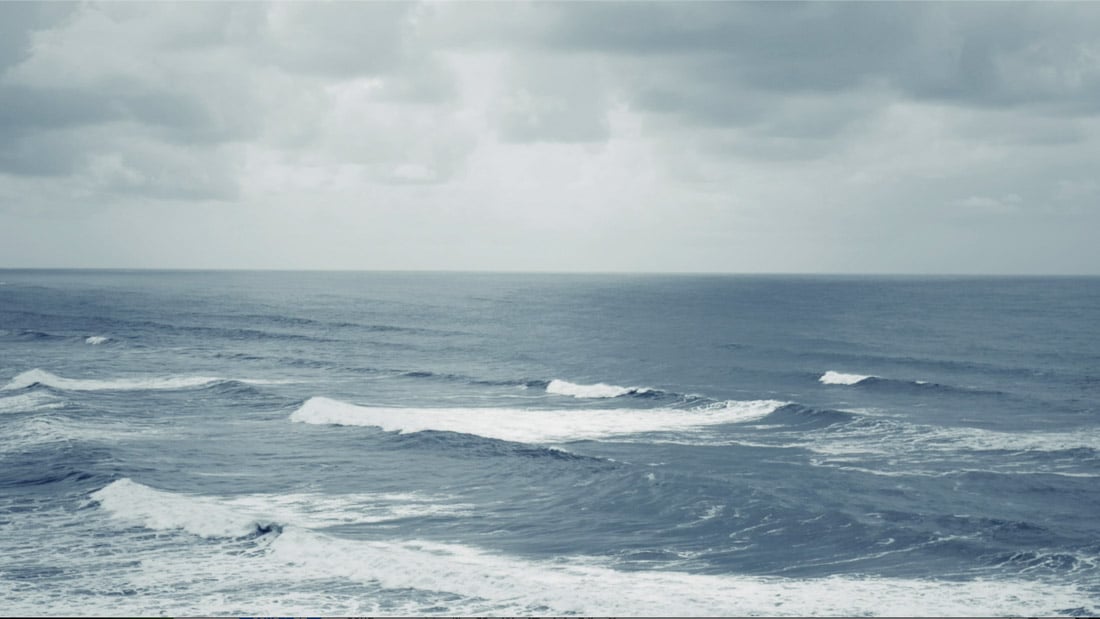Sky Hopinka: “maɬni – towards the ocean, towards the shore” A Student Response

Sky Hopinka: “maɬni – towards the ocean, towards the shore” A Student Response
Author: Morgan Holly
On October 8, 2021 the Bright Lights Film Series screened Sky Hopinka’s “maɬni – towards the ocean, towards the shore” in collaboration with the Emerson Contemporary Gallery. This was the first in-person film screening at Bright Lights since the pandemic, proving to be very special to all involved.
Sky Hopinka’s “maɬni – towards the ocean, towards the shore” follows his friends Sweetwater Sahme and Jordan Mercier as they exist within their lives and consider their culture, centering around beliefs related to the Chinookan origin of death myth. At the heart of the film are visuals of a meteorite that is sacred to an indigenous tribe in Oregon that is now showcased in a museum of natural history, the monolith acting as an anchor point for all the narratives, grounding life and death. At its core, “Maɬni – towards the ocean, towards the shore” shows how loss and life come full circle. With a rich soundscape, poetic context, and visuals, Sky Hopinka’s first feature film is an astonishing feat.
Hopinka’s primary concern when it came to creating his first feature film was how to make a film for indigenous people. He wanted the film not to focus on trauma and history, but to convey how cultural beliefs and practices exist in a modern setting through the lives of indigenous people. An area Hopinka was particularly interested in focusing on was beliefs that exist outside the Chistain influence. Hopinka found himself drawn to reincarnation and death, coming to center “maɬni – towards the ocean, towards the shore” on the Chinookan origin of death myth. However, Hopinka was not interested in depicting a history or a thorough explanation of the myth. Myths change over generations and Hopinka’s goal with this film was to look at how the origin of death myth affects people in modern times.
With “maɬni – towards the ocean, towards the shore,” Hopinka also wanted to tackle the question: What does language look like in a contemporary setting? The film, like Hopinka’s other works, is closely tied to the chinuk wawa language, “maɬni – towards the ocean, towards the shore” being mostly spoken in chinuk. While living in Portland, Hopinka studied and taught chinuk, a language indeigenous to the area. As an enrolled member of the Ho-Chunk Nation of Wisconsin and a descendent of the Pechanga Band of Luiseño Indians, the languages connected to his indigenous culture were thousands of miles away while he was located in the Pacific Northwest. With English as his first language, Hopinka had always been interested in learning an indigenous language and found the opportunity to do so in Portland.
“Maɬni – towards the ocean, towards the shore” aims to even language, the film being in both Chinuk and English. When Chinuk is spoken, English subtitles are on screen, and when English is spoken, Chinuk subtitles are given, both English and Chinuk appearing simultaneously at all times. In the Director’s Conversation, Hopinka revealed that his poetic narration that appears throughout the film was not written beforehand, Hopinka being better at speaking Chinuk than writing and not wanting to translate his poetry from an English form. So, Hopinka watched the film and audibly reacted to what he was thinking as the film played, which is how he created the poetic context that underlies the film. The way language is balanced in “maɬni – towards the ocean, towards the shore” allows the film to be accessible, connecting to the audience regardless of whether the viewer is able to speak Chinuk or not. By evening language, Hopinka revitalizes chinuk wawa, showing how chinuk wawa functions within a contemporary setting.
During the Director’s Conversation following the screening, Hopinka revealed details about his work process and experience as a filmmaker, giving advice to individuals interested in pursuing experimental filmmaking. In response to a question regarding the production process of “maɬni – towards the ocean, towards the shore,” Hopinka said “No one is going to ask you to make the films you want to make.” Hopinka encourages aspiring filmmakers to make the films they are passionate about, even if it is just for themselves. According to Hopinka, experimental films are incredibly difficult to pitch to production companies, and often filmmakers are left to create their projects independently. During his interview, Hopinka made it clear to experimental filmmakers: “You are your best resource.” Hopinka’s “Maɬni – towards the ocean, towards the shore” was made mostly with his own money and limited resources, the fellowships he received coming in at the end of the film’s creation and helping pay off some of the debt. However, while filming was difficult, it granted Hopinka creative freedom and autonomy over his own work, which proved to be worth it in the end.
There will be a virtual screening of “maɬni – towards the ocean, towards the shore” on October 27 and a virtual Director’s Conversation and Q&A with Sky Hopinka which will be led by Emerson professor and filmmaker Kathryn Ramey at 7pm EST. Tickets are free. If you are interested in seeing the film, tickets will be available to reserve on the Arts Emerson website. You can register for the Director’s Conversation and Q&A through the Bright Lights webinar registration form. The Sky Hopinka: Present Joys exhibition, which features some of his short films and artwork, is on view in the Media Art Gallery until November 7th.